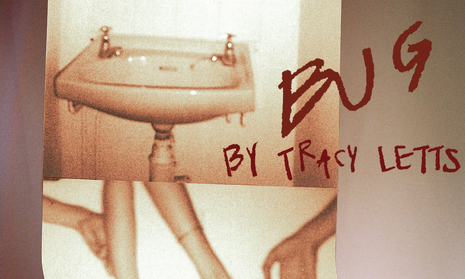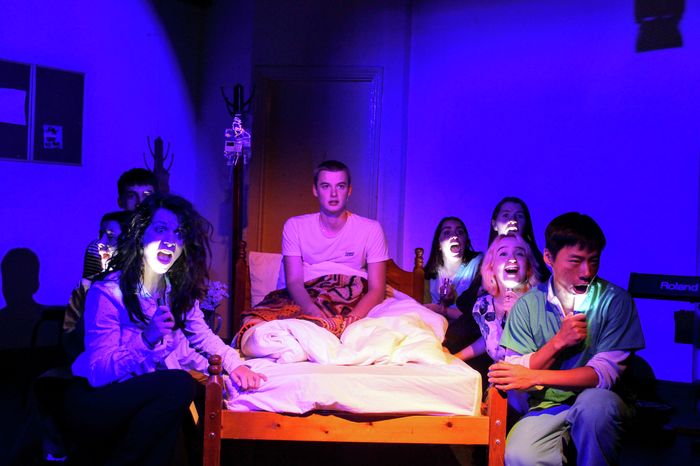Bug will get under your skin, one way or another
It takes just two to make a conspiracy, but Bug shows how many more it takes to make a well-staged production.

Conspiracy is catching. Just this month, Alex Jones was ordered to pay nearly $1bn for his lies about the Sandy Hook massacre. Now Kanye is fanning the age-old myth of a globalist Jewish cabal. And don’t forget the vaccine microchips, Ivermectin, 5G. They’re everywhere! With her production of Tracy Letts’ Bug (1996), director Bella Ridgwell takes the fervour of conspiracy theory to new heights of claustrophobia. Political, psychological, and philosophical, Bug will get under your skin, one way or another…
Burrowed in a seedy Oklahoma motel, Agnes (India Lewis) and Peter (Ollie Flowers) are put under the microscope in this exploration of a deprived, left-behind America. Agnes is hiding from her ex-husband, Jerry Goss (Daniel Patten), until Peter arrives with the possibility of company, sex, intimacy. And bugs…under his skin.
It’s easy to take the near-faultless acting for granted. These actors are transparent: all you can see is the character, complete with heavy Oklahoma accents. Patten brings the right amount of cruelty and lumbering physicality to Goss, while Maddy Power holds off our suffocation as R.C, the voice of reason in this pressure-chamber of paranoia. Isaac Jackson’s cameo as Dr. Sweet is short but, well, sweet, capturing the scoff of neoliberal snobbery—but dismiss Agnes and Peter as hillbilly rednecks at your own risk!
It takes just two to make a conspiracy, but Bug shows how many more it takes to make a well-staged production. Set designer Naphysa Awuah has a keen eye for crack-den decor. The pieces come together the more you look: the pill bottles, talc, half-eaten toast, tinfoil, coke. This is a refuge from something out there. Arianna Muñoz’s stellar sound design of whirring helicopters, intense crescendos pushes our protagonists tight within four walls, and lighting by Edward De’Ath keeps them there, fixed in expertly framed tableaux.
Unfortunately, the real ‘bug’ plaguing Letts’ script is its pacing. The first half struggles to take off, burdened by a plot without high stakes to pull us in—we’re told that Jerry Goss is dangerous, but do we believe it? When we return from the interval, however… cue everything! Letts’ play is lop-sided, and some of the later violence is ludicrously abrupt.
The second half is this play’s tonic, as ambivalence bursts into infection. Flowers’ transformation from terse, harmless child—talking through the door, hugging the walls—to grotesque maniac is a masterclass in characterisation. Agnes is reassured “he’s not an axe murderer,” but by the end of the play, you’ll wish that’s all he was.
Lewis’ performance is understated, festering. Weaving a conspiracy theory before our eyes, we realise these theories are born from the tragic material of Agnes’ own life. Conspiracy means ‘to breathe together,’ and the triumph of Flowers’ and Lewis’ performance is in this co-dependence, breathing life into each other, whatever the cost.
Crawling beneath this script is a masterpiece dying to burst out, and Ridgewell and her team work hard to break it open with passion and sensitivity. The play asks: why do people turn to conspiracy theories? In this case, the theories of the day seem to have left them out.
 News / Boat Race renamed in new Chanel partnership24 October 2024
News / Boat Race renamed in new Chanel partnership24 October 2024 Comment / The Grafton Centre is Cambridge’s true hidden gem22 October 2024
Comment / The Grafton Centre is Cambridge’s true hidden gem22 October 2024 Lifestyle / (Re)consider your college chapel25 October 2024
Lifestyle / (Re)consider your college chapel25 October 2024 News / Cambridge University partners with scandal hit drug manufacturers 25 October 2024
News / Cambridge University partners with scandal hit drug manufacturers 25 October 2024 Theatre / Fences goes the yard24 October 2024
Theatre / Fences goes the yard24 October 2024






